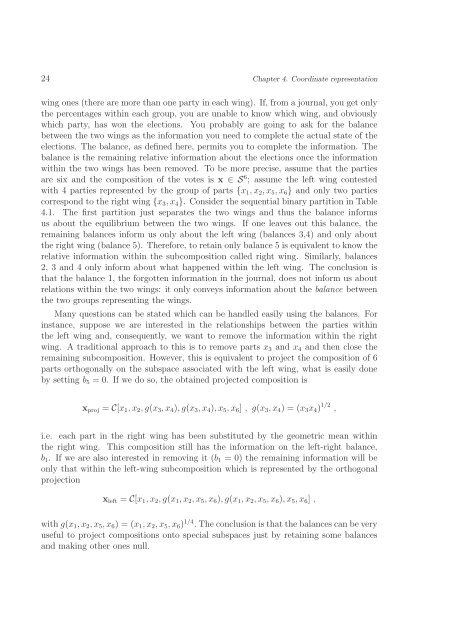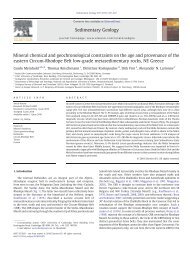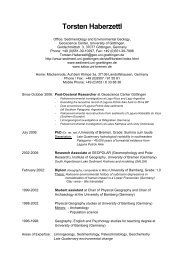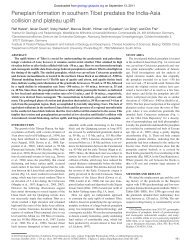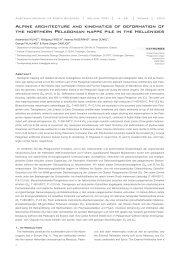Lecture Notes on Compositional Data Analysis - Sedimentology ...
Lecture Notes on Compositional Data Analysis - Sedimentology ...
Lecture Notes on Compositional Data Analysis - Sedimentology ...
You also want an ePaper? Increase the reach of your titles
YUMPU automatically turns print PDFs into web optimized ePapers that Google loves.
24 Chapter 4. Coordinate representati<strong>on</strong><br />
wing <strong>on</strong>es (there are more than <strong>on</strong>e party in each wing). If, from a journal, you get <strong>on</strong>ly<br />
the percentages within each group, you are unable to know which wing, and obviously<br />
which party, has w<strong>on</strong> the electi<strong>on</strong>s. You probably are going to ask for the balance<br />
between the two wings as the informati<strong>on</strong> you need to complete the actual state of the<br />
electi<strong>on</strong>s. The balance, as defined here, permits you to complete the informati<strong>on</strong>. The<br />
balance is the remaining relative informati<strong>on</strong> about the electi<strong>on</strong>s <strong>on</strong>ce the informati<strong>on</strong><br />
within the two wings has been removed. To be more precise, assume that the parties<br />
are six and the compositi<strong>on</strong> of the votes is x ∈ S 6 ; assume the left wing c<strong>on</strong>tested<br />
with 4 parties represented by the group of parts {x 1 , x 2 , x 5 , x 6 } and <strong>on</strong>ly two parties<br />
corresp<strong>on</strong>d to the right wing {x 3 , x 4 }. C<strong>on</strong>sider the sequential binary partiti<strong>on</strong> in Table<br />
4.1. The first partiti<strong>on</strong> just separates the two wings and thus the balance informs<br />
us about the equilibrium between the two wings. If <strong>on</strong>e leaves out this balance, the<br />
remaining balances inform us <strong>on</strong>ly about the left wing (balances 3,4) and <strong>on</strong>ly about<br />
the right wing (balance 5). Therefore, to retain <strong>on</strong>ly balance 5 is equivalent to know the<br />
relative informati<strong>on</strong> within the subcompositi<strong>on</strong> called right wing. Similarly, balances<br />
2, 3 and 4 <strong>on</strong>ly inform about what happened within the left wing. The c<strong>on</strong>clusi<strong>on</strong> is<br />
that the balance 1, the forgotten informati<strong>on</strong> in the journal, does not inform us about<br />
relati<strong>on</strong>s within the two wings: it <strong>on</strong>ly c<strong>on</strong>veys informati<strong>on</strong> about the balance between<br />
the two groups representing the wings.<br />
Many questi<strong>on</strong>s can be stated which can be handled easily using the balances. For<br />
instance, suppose we are interested in the relati<strong>on</strong>ships between the parties within<br />
the left wing and, c<strong>on</strong>sequently, we want to remove the informati<strong>on</strong> within the right<br />
wing. A traditi<strong>on</strong>al approach to this is to remove parts x 3 and x 4 and then close the<br />
remaining subcompositi<strong>on</strong>. However, this is equivalent to project the compositi<strong>on</strong> of 6<br />
parts orthog<strong>on</strong>ally <strong>on</strong> the subspace associated with the left wing, what is easily d<strong>on</strong>e<br />
by setting b 5 = 0. If we do so, the obtained projected compositi<strong>on</strong> is<br />
x proj = C[x 1 , x 2 , g(x 3 , x 4 ), g(x 3 , x 4 ), x 5 , x 6 ] , g(x 3 , x 4 ) = (x 3 x 4 ) 1/2 ,<br />
i.e. each part in the right wing has been substituted by the geometric mean within<br />
the right wing. This compositi<strong>on</strong> still has the informati<strong>on</strong> <strong>on</strong> the left-right balance,<br />
b 1 . If we are also interested in removing it (b 1 = 0) the remaining informati<strong>on</strong> will be<br />
<strong>on</strong>ly that within the left-wing subcompositi<strong>on</strong> which is represented by the orthog<strong>on</strong>al<br />
projecti<strong>on</strong><br />
x left = C[x 1 , x 2 , g(x 1 , x 2 , x 5 , x 6 ), g(x 1 , x 2 , x 5 , x 6 ), x 5 , x 6 ] ,<br />
with g(x 1 , x 2 , x 5 , x 6 ) = (x 1 , x 2 , x 5 , x 6 ) 1/4 . The c<strong>on</strong>clusi<strong>on</strong> is that the balances can be very<br />
useful to project compositi<strong>on</strong>s <strong>on</strong>to special subspaces just by retaining some balances<br />
and making other <strong>on</strong>es null.


